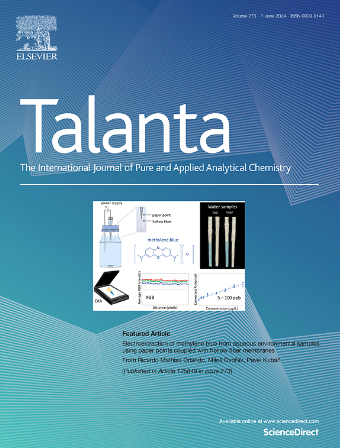A label-free fluorescence aptasensor for salivary exosomes based on a nano-micro dual-scale signal amplification strategy
IF 5.6
1区 化学
Q1 CHEMISTRY, ANALYTICAL
引用次数: 0
Abstract
Oral squamous cell carcinoma (OSCC) is the most prevalent histological subtype of oral cancer and urgently requires a noninvasive approach for timely detection to improve patients’ prognose. Salivary exosome act as a promising biomarker, while the complex and expensive analytical methods impeded its popularization in clinical applications. In this study, we developed a label-free aptasensor for salivary exosomes that utilizes a “one exosome to multiple carbon dots” signal conversion method along with nano-micro dual-scale signal amplification strategy. SiO2 microspheres served as substrates, while carbon dots acted as luminophores, with CD63 aptamers functioning as selective recognition elements. Exosomes compete to bind with the aptamers, thereby leading to the release of non-specifically adsorbed carbon dots from the substrates. The concentration of exosomes is proportional to the variation in fluorescence intensity, enabling highly sensitive detection in artificial saliva samples, with a favorable linearity range of 2.5 × 102∼5 × 108 particles/mL and a relatively low LOD of 100 particles/mL. The anti-interference ability is deemed acceptable, and the fabrication process is affordable coupled with a straightforward signal output mode. The aptasensor was applied successfully to distinguish OSCC patients from healthy individuals, suggesting its potential for screening OSCC in physical examination centers and communities.

求助全文
约1分钟内获得全文
求助全文
来源期刊

Talanta
化学-分析化学
CiteScore
12.30
自引率
4.90%
发文量
861
审稿时长
29 days
期刊介绍:
Talanta provides a forum for the publication of original research papers, short communications, and critical reviews in all branches of pure and applied analytical chemistry. Papers are evaluated based on established guidelines, including the fundamental nature of the study, scientific novelty, substantial improvement or advantage over existing technology or methods, and demonstrated analytical applicability. Original research papers on fundamental studies, and on novel sensor and instrumentation developments, are encouraged. Novel or improved applications in areas such as clinical and biological chemistry, environmental analysis, geochemistry, materials science and engineering, and analytical platforms for omics development are welcome.
Analytical performance of methods should be determined, including interference and matrix effects, and methods should be validated by comparison with a standard method, or analysis of a certified reference material. Simple spiking recoveries may not be sufficient. The developed method should especially comprise information on selectivity, sensitivity, detection limits, accuracy, and reliability. However, applying official validation or robustness studies to a routine method or technique does not necessarily constitute novelty. Proper statistical treatment of the data should be provided. Relevant literature should be cited, including related publications by the authors, and authors should discuss how their proposed methodology compares with previously reported methods.
 求助内容:
求助内容: 应助结果提醒方式:
应助结果提醒方式:


